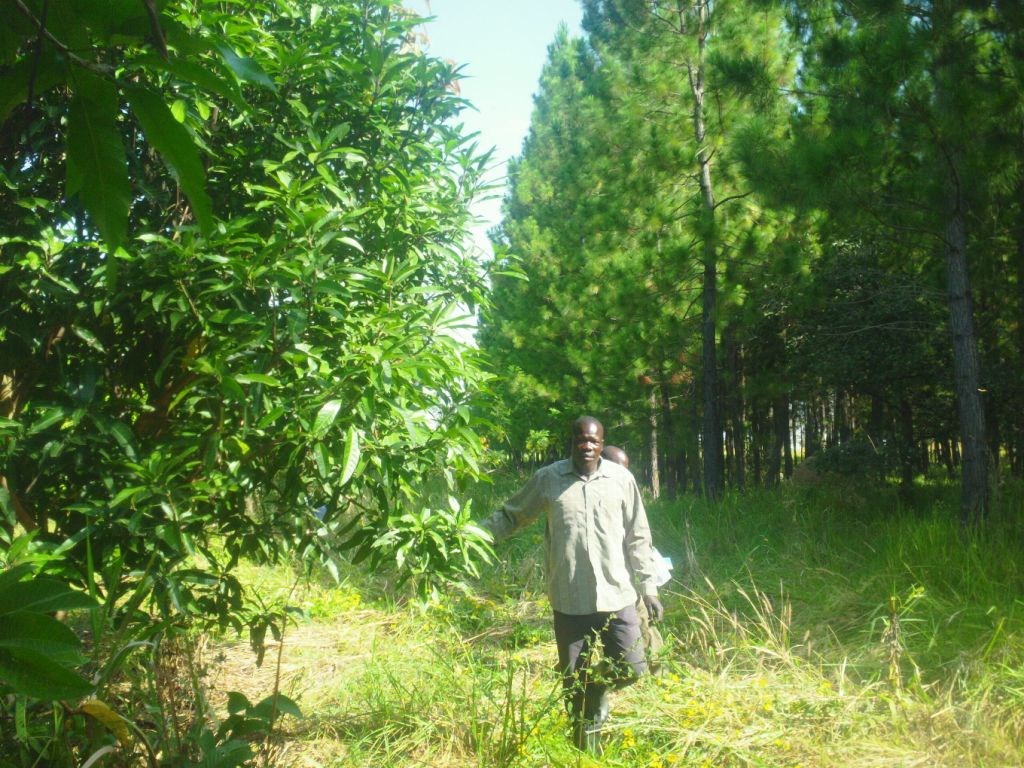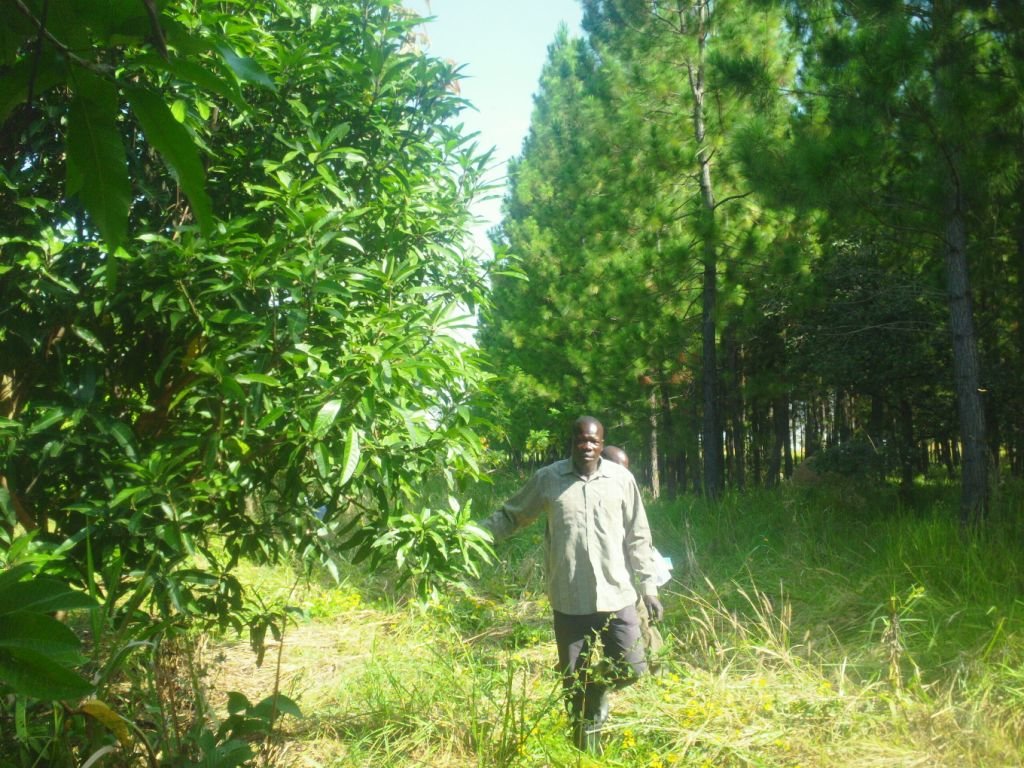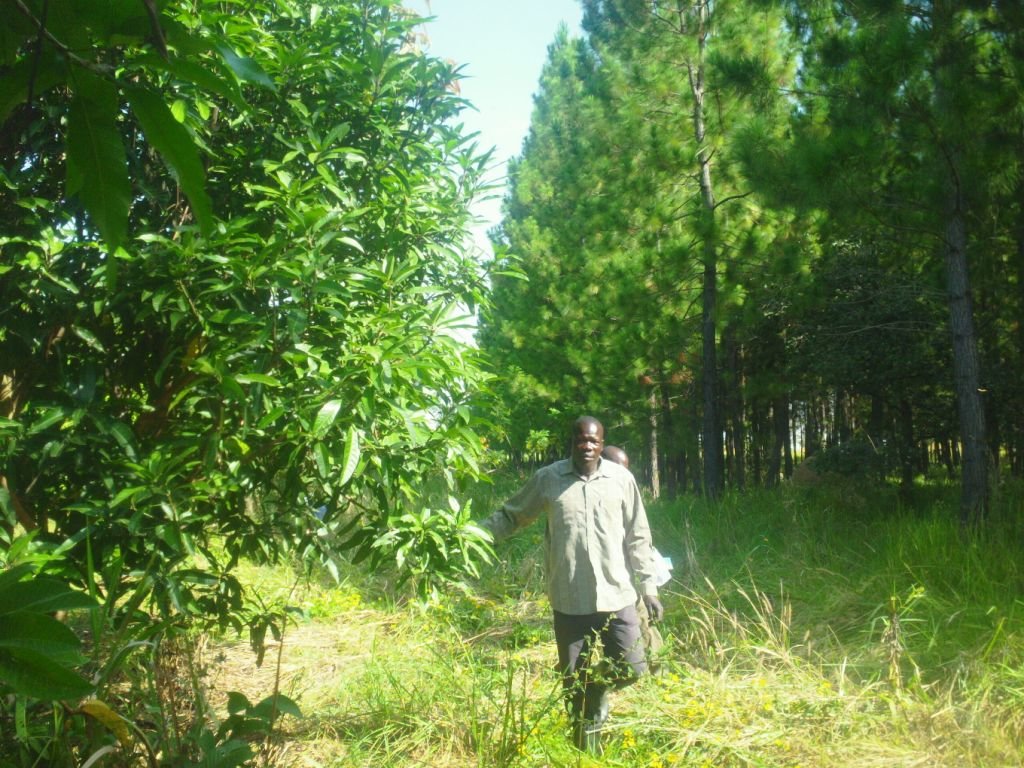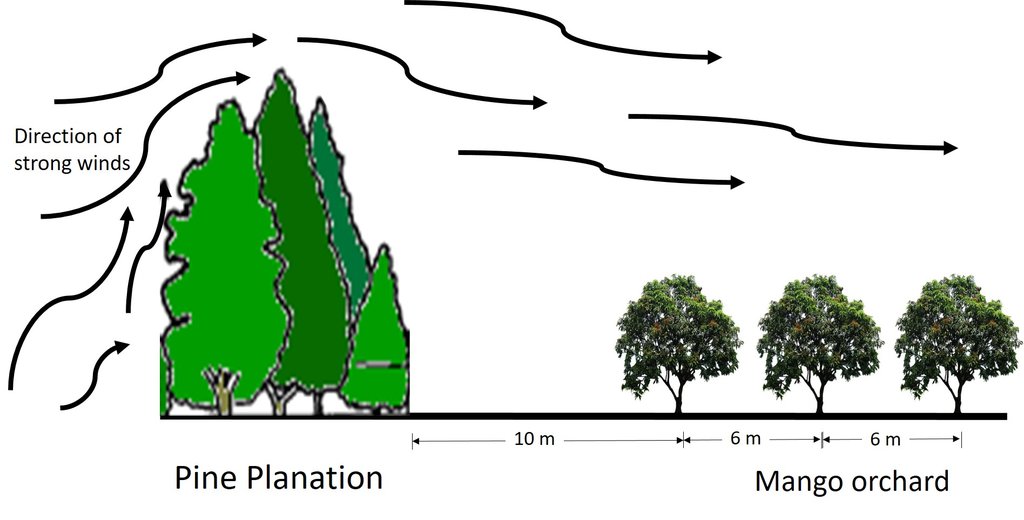Pine-shielded mango growing [Uganda]
- Creation:
- Update:
- Compiler: Bernard Fungo
- Editors: JOY TUKAHIRWA, Kamugisha Rick Nelson, betty adoch, Sunday Balla Amale
- Reviewers: Nicole Harari, Renate Fleiner
Pito yen PIne Inget mayembe
technologies_2880 - Uganda
View sections
Expand all Collapse all1. General information
1.2 Contact details of resource persons and institutions involved in the assessment and documentation of the Technology
Key resource person(s)
land user:
Abok Robert
+256786841627
Amuru district Local Government
Amuru district
Uganda
Name of project which facilitated the documentation/ evaluation of the Technology (if relevant)
Scaling-up SLM practices by smallholder farmers (IFAD)Name of the institution(s) which facilitated the documentation/ evaluation of the Technology (if relevant)
Uganda Landcare Network (ULN) - Uganda1.3 Conditions regarding the use of data documented through WOCAT
When were the data compiled (in the field)?
11/05/2017
The compiler and key resource person(s) accept the conditions regarding the use of data documented through WOCAT:
Ja
1.4 Declaration on sustainability of the described Technology
Is the Technology described here problematic with regard to land degradation, so that it cannot be declared a sustainable land management technology?
Nee
2. Description of the SLM Technology
2.1 Short description of the Technology
Definition of the Technology:
Pine-based shelter belt is used to protect an orchard of mangoes against strong winds in order to prevent abscission of generative organs such as flower buds, flowers, small fruits and ripened fruits
2.2 Detailed description of the Technology
Description:
Falling of flower buds and young fruits are brought about by strong winds common in northern Uganda. This can significantly reduce the number of fruits harvested and therefore cause a reduction in income to the farmer.
Fruit trees (mainly mangoes and oranges) are protected from strong winds by establishing a pine plantation beside the orchard. The plantation of pine is established in the direction from where the strong winds come and the fruit trees are established on the opposite side so that the wind velocity is reduced by the pines before it damages the fruit trees. This is because pine trees generally grow taller than the fruit trees and thus provide a shield against strong winds. Individual plants of the fruit trees are planted at a spacing of 6 x 6 m within and between rows. The spacing between the fruit trees and pine trees is approximately 10 meters. Within five years, pine trees reach a size of about 8 meters high and a diameter of about 15 cm. The fruit trees and the pines are established at the same time and all management activities such as weeding, pruning and thinning are done in a manner similar to conventional management practice for individual orchards or pine plantations.
The most important inputs for this technology are the seedlings, labour for planting and periodic activities such as weeding, thinning and pruning. On average, a seedling of a fruit tree costs about UGX 3,000 while a pine tree costs UGX 500. Approximately 500 trees are planted in an acre of land in the ratio of 3:1 for fruit tree to pine tree, respectively. This technology is suitable for farmers who have extra land besides that for the orchards, in order to plant pine shelterbelts.
One great advantage of this technology to farmers is that it provides benefits from both pine plantation and from the orchard. According to the farmer, controlling wind speed using pine shelterbelts can improve the yield of the fruit trees by up to 50% which compensates for the number of fruit trees being reduced by 30%. Nonetheless, the return on investment is high, mainly due to the high price fetched for the fruits from the orchard. This technology is also a climate change adaptation strategy because it guards against extreme weather events such as strong winds, diversifies farmers income and mitigates climate change through carbon sequestration in pine plantation.
Despite the advantages, the farmer was abhorrent of the high establishment costs that are also relatively high compared to the costs a farmer has growing only orchards. The payback period is also fairly long, approaching 5 years for the orchard and 15-20 years for the timber from the pines. A further challenge is how to manage drought and heavy winds that are becoming more frequent and extreme.
Shielding orchards is done where the land is generally flat and the winds are strong such as in the plains of northern Uganda. It is suitable where both fruit trees and timber provide equally important products for the market.
2.3 Photos of the Technology
2.5 Country/ region/ locations where the Technology has been applied and which are covered by this assessment
Country:
Uganda
Region/ State/ Province:
Northern
Map
×2.6 Date of implementation
Indicate year of implementation:
2013
If precise year is not known, indicate approximate date:
- less than 10 years ago (recently)
2.7 Introduction of the Technology
Specify how the Technology was introduced:
- through land users' innovation
3. Classification of the SLM Technology
3.1 Main purpose(s) of the Technology
- reduce, prevent, restore land degradation
- reduce risk of disasters
- adapt to climate change/ extremes and its impacts
- mitigate climate change and its impacts
- create beneficial economic impact
3.2 Current land use type(s) where the Technology is applied

Cropland
- Perennial (non-woody) cropping

Forest/ woodlands
Products and services:
- Fruits and nuts
3.3 Further information about land use
Water supply for the land on which the Technology is applied:
- rainfed
Number of growing seasons per year:
- 2
3.4 SLM group to which the Technology belongs
- forest plantation management
- agroforestry
- windbreak/ shelterbelt
3.5 Spread of the Technology
Specify the spread of the Technology:
- evenly spread over an area
If the Technology is evenly spread over an area, indicate approximate area covered:
- < 0.1 km2 (10 ha)
3.6 SLM measures comprising the Technology

vegetative measures
- V1: Tree and shrub cover

management measures
- M5: Control/ change of species composition
3.7 Main types of land degradation addressed by the Technology

soil erosion by wind
- Et: loss of topsoil
- Ed: deflation and deposition
- Eo: offsite degradation effects

other
Comments:
Climate extremes (Winds)
3.8 Prevention, reduction, or restoration of land degradation
Specify the goal of the Technology with regard to land degradation:
- reduce land degradation
- adapt to land degradation
Comments:
Reduces land degradation through C sequestration in tree biomass
4. Technical specifications, implementation activities, inputs, and costs
4.1 Technical drawing of the Technology
4.2 Technical specifications/ explanations of technical drawing
Pine trees spaced at 3 x 3 meters throughout the plantation
Approximately 500 trees per acre
Mango trees planted 10 meters away from the Pine trees
spacing of mangoes is 6 x 6 meters
4.3 General information regarding the calculation of inputs and costs
Specify how costs and inputs were calculated:
- per Technology area
Indicate size and area unit:
Acres
If using a local area unit, indicate conversion factor to one hectare:
0.4
other/ national currency (specify):
Uganda Shillings
Indicate exchange rate from USD to local currency (if relevant): 1 USD =:
3500.0
Indicate average wage cost of hired labour per day:
5000
4.4 Establishment activities
| Activity | Type of measure | Timing | |
|---|---|---|---|
| 1. | Clearing of land | Management | At the beginning of the season |
| 2. | Planting | Management | Once at the start of the establishment |
| 3. | Weeding | Management | |
| 4. | Thinning of pine plantation | Management | |
| 5. | Pruning of the pine plantation | Management | At age 3 and 7 years |
4.5 Costs and inputs needed for establishment
| Specify input | Unit | Quantity | Costs per Unit | Total costs per input | % of costs borne by land users | |
|---|---|---|---|---|---|---|
| Labour | Land preparation | Acre | 1.0 | 200000.0 | 200000.0 | 100.0 |
| Labour | Planting | Acre | 1.0 | 100000.0 | 100000.0 | 100.0 |
| Plant material | Seedlings of Pine | Acre | 500.0 | 500.0 | 250000.0 | 100.0 |
| Plant material | Seedlings of Mangoes | Acre | 300.0 | 3000.0 | 900000.0 | 100.0 |
| Total costs for establishment of the Technology | 1450000.0 | |||||
4.6 Maintenance/ recurrent activities
| Activity | Type of measure | Timing/ frequency | |
|---|---|---|---|
| 1. | Weeding | Agronomic | Twice a year for the first year and once a year thereafter |
| 2. | Pruning | Agronomic | At age 3 and 7 years |
| 3. | Thining | Agronomic | At age 4 and 8 years |
4.7 Costs and inputs needed for maintenance/ recurrent activities (per year)
| Specify input | Unit | Quantity | Costs per Unit | Total costs per input | % of costs borne by land users | |
|---|---|---|---|---|---|---|
| Labour | Weeding | Acre | 1.0 | 100000.0 | 100000.0 | 100.0 |
| Labour | Pruning of Pine | Acre | 1.0 | 20000.0 | 20000.0 | 100.0 |
| Labour | Thinning of Pine | Acre | 1.0 | 200000.0 | 200000.0 | 100.0 |
| Plant material | Seedlings for beating-up - Pine | Number | 100.0 | 500.0 | 50000.0 | 100.0 |
| Plant material | Seedlings for beating-up - Mangoes | Number | 50.0 | 3000.0 | 150000.0 | 100.0 |
| Total costs for maintenance of the Technology | 520000.0 | |||||
4.8 Most important factors affecting the costs
Describe the most determinate factors affecting the costs:
Land preparation and planting
5. Natural and human environment
5.1 Climate
Annual rainfall
- < 250 mm
- 251-500 mm
- 501-750 mm
- 751-1,000 mm
- 1,001-1,500 mm
- 1,501-2,000 mm
- 2,001-3,000 mm
- 3,001-4,000 mm
- > 4,000 mm
Agro-climatic zone
- sub-humid
5.2 Topography
Slopes on average:
- flat (0-2%)
- gentle (3-5%)
- moderate (6-10%)
- rolling (11-15%)
- hilly (16-30%)
- steep (31-60%)
- very steep (>60%)
Landforms:
- plateau/plains
- ridges
- mountain slopes
- hill slopes
- footslopes
- valley floors
Altitudinal zone:
- 0-100 m a.s.l.
- 101-500 m a.s.l.
- 501-1,000 m a.s.l.
- 1,001-1,500 m a.s.l.
- 1,501-2,000 m a.s.l.
- 2,001-2,500 m a.s.l.
- 2,501-3,000 m a.s.l.
- 3,001-4,000 m a.s.l.
- > 4,000 m a.s.l.
Indicate if the Technology is specifically applied in:
- not relevant
5.3 Soils
Soil depth on average:
- very shallow (0-20 cm)
- shallow (21-50 cm)
- moderately deep (51-80 cm)
- deep (81-120 cm)
- very deep (> 120 cm)
Soil texture (topsoil):
- medium (loamy, silty)
Soil texture (> 20 cm below surface):
- medium (loamy, silty)
Topsoil organic matter:
- medium (1-3%)
5.4 Water availability and quality
Ground water table:
5-50 m
Availability of surface water:
medium
Water quality (untreated):
poor drinking water (treatment required)
Is water salinity a problem?
Nee
Is flooding of the area occurring?
Nee
5.5 Biodiversity
Species diversity:
- medium
Habitat diversity:
- medium
5.6 Characteristics of land users applying the Technology
Sedentary or nomadic:
- Sedentary
Market orientation of production system:
- mixed (subsistence/ commercial
Off-farm income:
- less than 10% of all income
Relative level of wealth:
- average
Individuals or groups:
- individual/ household
Level of mechanization:
- manual work
Gender:
- men
Age of land users:
- middle-aged
5.7 Average area of land owned or leased by land users applying the Technology
- < 0.5 ha
- 0.5-1 ha
- 1-2 ha
- 2-5 ha
- 5-15 ha
- 15-50 ha
- 50-100 ha
- 100-500 ha
- 500-1,000 ha
- 1,000-10,000 ha
- > 10,000 ha
Is this considered small-, medium- or large-scale (referring to local context)?
- medium-scale
5.8 Land ownership, land use rights, and water use rights
Land ownership:
- individual, not titled
Land use rights:
- individual
Water use rights:
- communal (organized)
5.9 Access to services and infrastructure
health:
- poor
- moderate
- good
education:
- poor
- moderate
- good
technical assistance:
- poor
- moderate
- good
employment (e.g. off-farm):
- poor
- moderate
- good
markets:
- poor
- moderate
- good
energy:
- poor
- moderate
- good
roads and transport:
- poor
- moderate
- good
drinking water and sanitation:
- poor
- moderate
- good
financial services:
- poor
- moderate
- good
6. Impacts and concluding statements
6.1 On-site impacts the Technology has shown
Socio-economic impacts
Income and costs
expenses on agricultural inputs
farm income
diversity of income sources
Socio-cultural impacts
food security/ self-sufficiency
SLM/ land degradation knowledge
Ecological impacts
Soil
soil moisture
Climate and disaster risk reduction
drought impacts
wind velocity
micro-climate
6.2 Off-site impacts the Technology has shown
wind transported sediments
6.3 Exposure and sensitivity of the Technology to gradual climate change and climate-related extremes/ disasters (as perceived by land users)
Climate-related extremes (disasters)
Other climate-related extremes (disasters)
| other (specify) | How does the Technology cope with it? |
|---|---|
| Wind speed | moderately |
6.4 Cost-benefit analysis
How do the benefits compare with the establishment costs (from land users’ perspective)?
Short-term returns:
very negative
Long-term returns:
very positive
How do the benefits compare with the maintenance/ recurrent costs (from land users' perspective)?
Short-term returns:
slightly negative
Long-term returns:
very positive
6.5 Adoption of the Technology
- single cases/ experimental
Of all those who have adopted the Technology, how many have did so spontaneously, i.e. without receiving any material incentives/ payments?
- 0-10%
6.6 Adaptation
Has the Technology been modified recently to adapt to changing conditions?
Nee
6.7 Strengths/ advantages/ opportunities of the Technology
| Strengths/ advantages/ opportunities in the land user’s view |
|---|
| Improvement in income |
| Increase production diversification |
| Increased social security because trees provide benefits over long periods of time |
6.8 Weaknesses/ disadvantages/ risks of the Technology and ways of overcoming them
| Weaknesses/ disadvantages/ risks in the land user’s view | How can they be overcome? |
|---|---|
| Very high cost of establishment, not affordable by many farmers | Do gradual planting instead of embarking on larger area than one can afford |
| There is high risk of damage to young trees by grazing animals in the areas, especially during dry season | Fence-off the area, especially the orchard |
| Pest and disease of mangoes result in severe damage to the orchard | Treat according to recommended schedule |
| Weaknesses/ disadvantages/ risks in the compiler’s or other key resource person’s view | How can they be overcome? |
|---|---|
| The technology requires large areas of both orchard and pine plantation, which are not available among a majority of farmers in the area. | Joint land-use planning at community level to determine appropriate cropping mixtures in the landscape. |
| Timing of establishment of the orchard has to be done after the pine has grown to a height of 3-4 meters (about 2 years). This is a fairly heavy investment for low-income farmers in a very short time before the actual benefits begin to accrue. | Sourcing for low-interest loans from commercial banks and other microfinance institutions |
7. References and links
7.1 Methods/ sources of information
- field visits, field surveys
1
- interviews with land users
1
7.2 References to available publications
Title, author, year, ISBN:
N/a
7.3 Links to relevant information which is available online
Title/ description:
N/A
Links and modules
Expand all Collapse allLinks
No links
Modules
No modules






